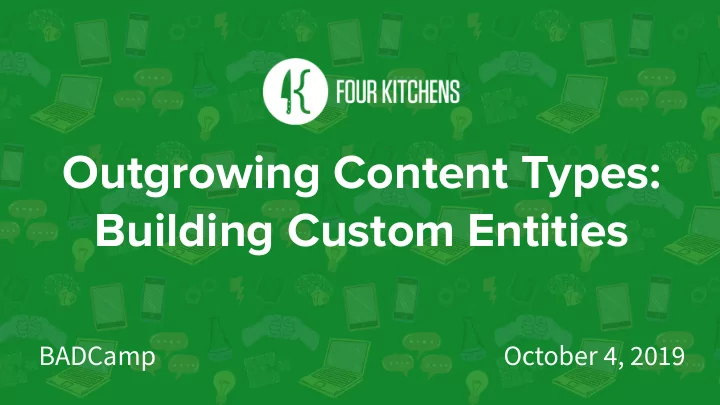

Outgrowing Content Types: Building Custom Entities BADCamp October 4, 2019
Jim.Vomero@FourKitchens.com @nJim
Four Kitchens builds websites and apps for organizations that depend on large-scale or unconventional content.
What is an entity?
Drupal 6 ● Added a DB abstraction layer. ● CCK module extended content types. ● The idea of fieldable-content pushed us toward making everything a node.
Drupal 7 ● Intentionally an abstract term, entities are objects that are used for persistent storage of content and configuration information ● Entities become a stdObject in core. ● Nodes, Taxonomy, Users, others are fieldable.
Drupal 8 ● Entities are defined with typed objects. ● Interfaces enforce consistent implementations. ● Includes Content and Configuration entities. While both are relevant, this presentation will focus on content entities.
Core & Contrib Entities
Core Entities Entity Bundle Module Usage Content Content Type node Traditional content page. User none user Access accounts. Custom Block Block Type custom_block Ancillary content items. Taxonomy Term Vocabulary taxonomy Tagging and feeds. Media Media Type media Multimedia and metadata. File none file Files and metadata. Additional core entities include: Comment, Contact Form, Menu Link Content, and Shortcut among others.
Contrib Entities Entity Module Usage Paragraph paragraph Content components. Webforms / Submissions webform Form builder / storage. Pathauto Patterns pathauto URL alias definitions. Metatag Defaults metatag Per content metatag settings. Redirect redirect Redirect (4xx response) management. Group group Define entity collections.
Why create custom entities? ● Presentation ● Reducing Overhead ● Access ● Performance ● Optimizing Builds ● Storage
Reason #1: Reducing Overhead When content types are too big.
Reason #1: Reducing Overhead When content types are too big. Raspberry Pi Data Feed ● New temperature reading every minute via API. ● Logs include temperature and timestamp only. ● No need for traditional editorial controls.
Reason #2: Optimizing When content types are too small. Regional Microsites ● Non-Profit is adding sites for each metro area. ● Organization wide content will mix with local. ● Stakeholders value consistency between sites.
Reason #3: Presentation Presenting customized editorial experiences. Timecards ● Unique access for Staff, Manager, and Finance. ● Different forms based user role and workflow status. ● All changes logged for financial integrity.
Reason #4: Access Defining unique access controls & permissions. Ticketing System ● Multiple issue types with unique workflows. ● Dynamic permissions per role, type, and status. ● User, Help Desk, Admin Management roles.
Reason #5: Leveraging Bundles Reusing content definitions through bundles. Session Keynote Workshop Social BOF Title Title Title Title Title Location Location Location Location Location Timeslot Timeslot Timeslot Timeslot Timeslot Description Description Description Description Description Image Image Image Image Track Track Banner Image Registration Registration
Reason #6: Performance Tuning When performance is an high valued goal.
Reason #6: Performance Tuning When performance is an high valued goal. Denormalizing can: ● Enhance query performance. ● Make a database more convenient to manage ● Facilitate and accelerate reporting.
Reason #7: Unique Storage Using non-standard storage for modeled data. Example: https://www.drupal.org/project/external_entities
Are you Excited? Feel Empowered? Ready to create Entities?
Reasons not to build a custom entity. 1. Steeper learning curve compared to other Drupal APIs. 2. Less likely contrib modules will work with custom entities. 3. Custom entities may not inherit future Drupal features. 4. Responsible for maintaining custom code - plenty of potential for technical debt.
Building with ECK Module Demo
Generating with Drupal Console Demo
Thank You! Jim.Vomero@FourKitchens.com @nJim
Recommend
More recommend